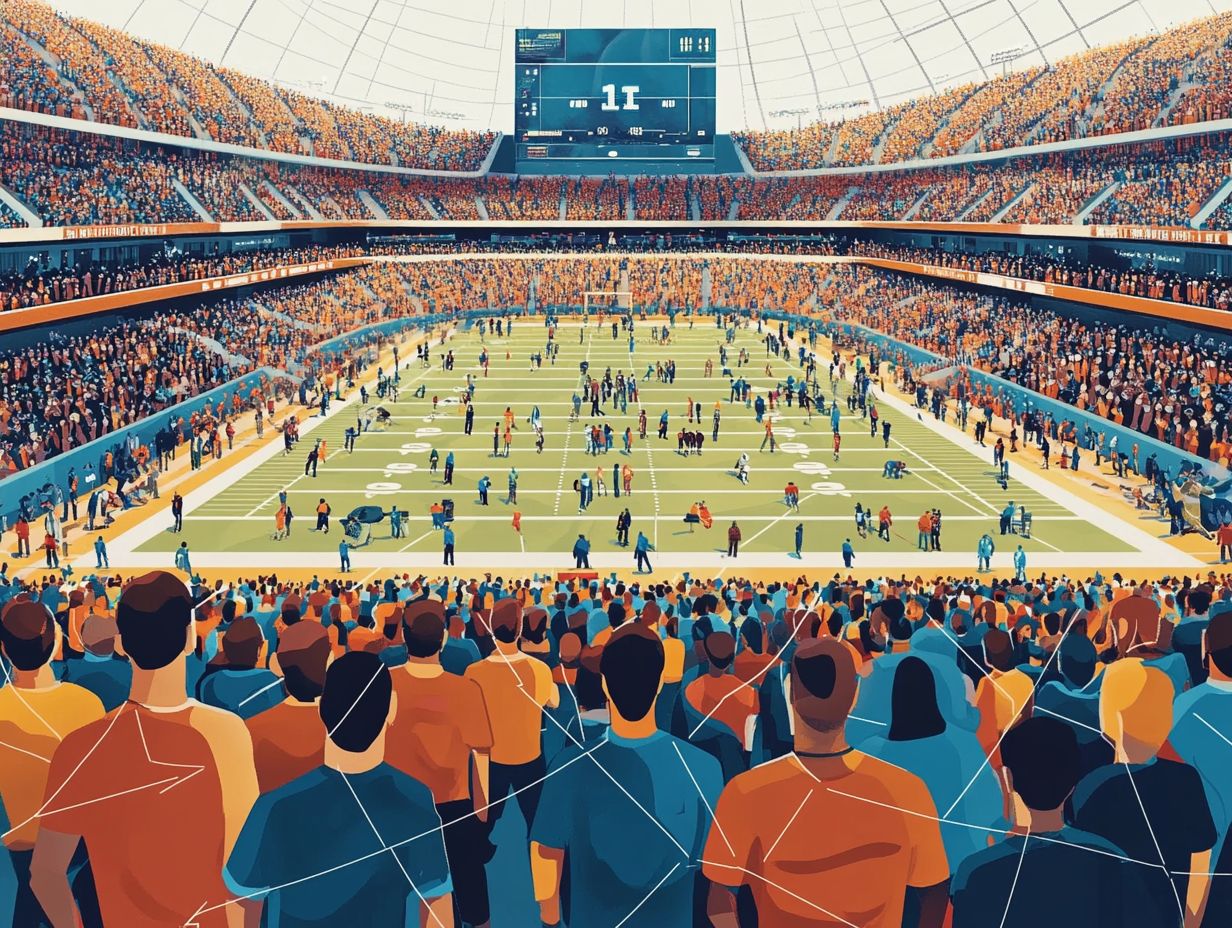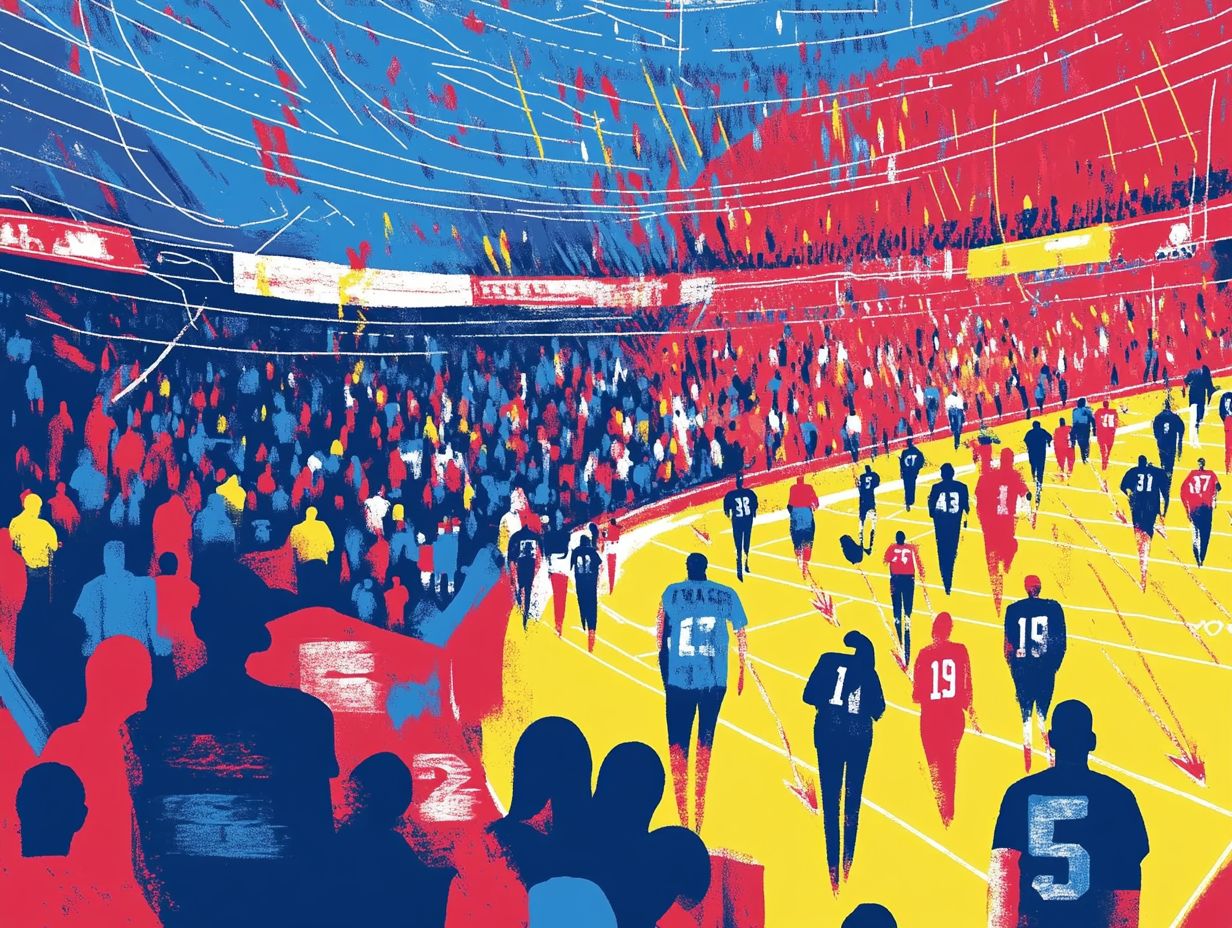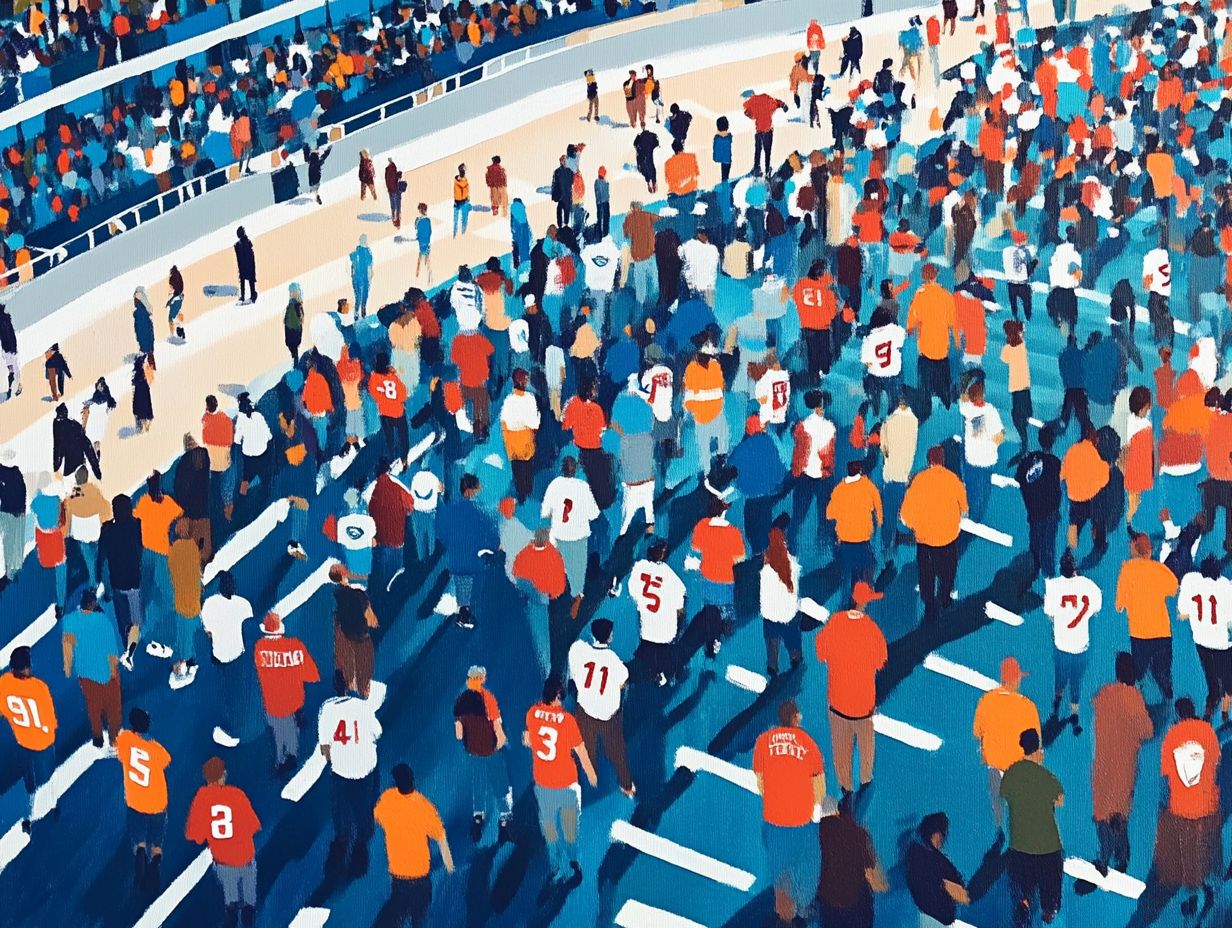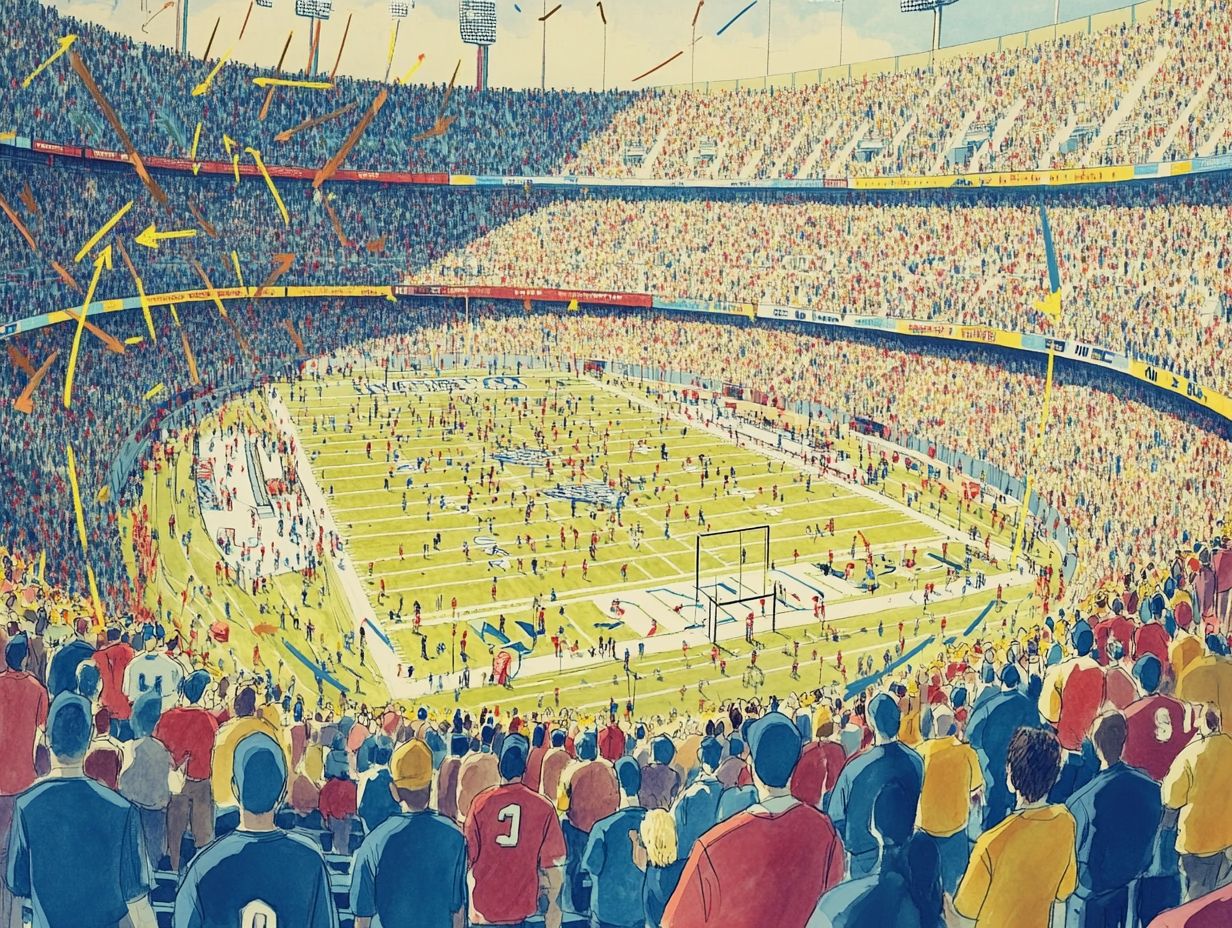In today’s rapidly evolving sports landscape, understanding sports fan behavior is crucial. Stadium foot traffic analytics provide valuable insights into how fan behavior interacts with their surroundings, influencing everything from merchandise sales to overall game-day experiences. This article explores the factors that affect fan behavior, the benefits of utilizing foot traffic data to enhance fan engagement and revenue, and the steps necessary for successful implementation. It also considers the future of this technology and potential advancements.
**Factors Affecting Fan Behavior**
Several characteristics shape the behavior of sports fans on game days, including their demographic profile, level of enthusiasm, and key trends in the industry, such as seating arrangements and weather conditions.
– **Age:** Younger fans are typically more engaged on social media and are more likely to participate in gamified brand interactions, reflecting significant social media influence, while older fans may prefer traditional methods of engagement, such as phone calls.
– **Gender:** Men are generally more inclined to attend games in person, whereas women tend to attend less frequently and are less likely to watch games on television.
– **Enthusiasm Level:** Fans who hold season tickets often arrive at games significantly earlier and spend more time in the stadium compared to average attendees.
– **Trends:** The availability of more seating in the lower bowl of stadiums allows fans to be closer to the action during games.
– **Weather:** Fans are more likely to spend extended periods in the stadium when the weather is warmer, impacting venue traffic and attendance patterns.
**Benefits of Using Stadium Foot Traffic Data to Improve Fan Engagement, Venue Traffic, and Revenue**
Insights derived from fan behavior analytics enable sports organizations to implement targeted strategies that enhance engagement and revenue across various areas:
– **Merchandise Sales:** By understanding when and where stadium foot traffic analytics show traffic is highest, organizations can identify the most effective times to promote specific merchandise. For instance, if analytics reveal increased foot traffic at halftime, introducing a limited-time promotion can encourage purchases as fans prepare for the second half of the game.
– **Food and Beverage Outlets:** Similar strategies can be applied to food and beverage sales by using data analysis and analytics to determine peak traffic periods and optimize offerings accordingly.
– **Fan Engagement Opportunities:** Analytics can highlight quieter moments that are ideal for engaging fans with activities such as appearances by team mascots, ensuring these opportunities receive adequate attention.
– **Security and Safety:** Security teams can leverage fan behavior analytics and crowd management techniques to monitor and promptly respond to unusual activities. If analytics indicate heavy foot traffic in a specific area, security personnel can be strategically deployed to prevent potential incidents.
– **Enhanced Game-Day Experiences:** Foot traffic analytics can shed light on how individual fan experiences and crowd dynamics influence overall game-day satisfaction. Unlike traditional surveys, which often rely on small samples, foot traffic analytics can confirm and target areas for improvement more effectively.
**How to Implement Stadium Foot Traffic Data to Improve Fan Engagement and Revenue**
1. **Collecting the Data:** Sports organizations can utilize advanced video and mobile location analytics technology to gather real-time data and improve operational efficiency. This technology has evolved to ensure minimal user privacy concerns during data collection.
2. **Using the Data:** Organizations must determine how to utilize the data effectively. Stakeholders, including management and third-party analytics providers, should agree on relevant metrics that align with the organization’s needs and how to assign monetary value to them.
3. **Data Maintenance:** After establishing the technology and agreeing on its use, organizations must ensure that the system functions efficiently and that users receive proper training.
4. **Ensuring the System Remains Efficient:** Ongoing maintenance is essential to prevent technological disrepair. Regular updates to both infrastructure and software are necessary, and users should be properly trained to avoid jeopardizing organizational goals.
5. **Metrics Must Remain Relevant:** Stakeholders should meet periodically to assess whether the system continues to align with the organization’s objectives.
**Future of Stadium Foot Traffic Data Technology and Analytics**
The future of stadium foot traffic data technology and analytics is expected to be shaped by several trends:
– **More Affordable Technology:** As technology advances, the costs of hardware and software are likely to decrease.
– **Increased Adoption:** As prices drop, more organizations will likely leverage this technology to enhance operational efficiency and event management.
– **Expanded Data Collection:** As the sports industry becomes more sophisticated, organizations will seek to collect a broader range of metrics.
– **Improvements in Existing Metrics:** Advancements in technology will enable users to enhance the accuracy of current metrics, allowing organizations to derive greater value from the data collected.
Understanding Sports Fan Behavior

Understanding sports fan behavior is essential for enhancing the game day experience and increasing fan loyalty and satisfaction.
By examining factors such as demographics, attendance patterns, and emotional engagement, sports organizations can refine their marketing strategies to maximize fan engagement and improve venue utilization.
Behavioral analytics and consumer insights can reveal new opportunities for optimizing the customer journey, increasing operational efficiency, and maximizing ticket sales through effective loyalty programs and audience segmentation.
Factors Influencing Fan Behavior
Several factors influence sports fan behavior, including fan motivation, emotional involvement, and social media interaction, all of which impact attendance patterns. These elements shape how individuals connect with their teams and the broader sports community.
For example, understanding what drives a fan’s motivation—whether it is socialization, competition, or the excitement of live entertainment—can significantly enhance engagement. Social media facilitates real-time interaction among fans and serves as a valuable tool for teams to gauge sentiment, conduct sentiment analysis, and tailor experiences.
This comprehensive understanding of fan behavior can aid in audience segmentation, enabling franchises to effectively communicate with and engage the right audiences, ultimately improving event attendance and fostering a stronger, more committed fan base.
Benefits of Using Stadium Foot Traffic Analytics

Stadium foot traffic analytics offer several benefits, including improved operational efficiency, enhanced visitor behavior insights, and better traffic flow analysis.
By utilizing real-time data and data visualization, sports organizations can optimize venue design, layout, and operational metrics. This not only enhances the game day experience for fans but also creates increased revenue opportunities through effective marketing initiatives.
Improved Fan Experience and Revenue Generation
Enhancing the fan experience through stadium analytics presents significant revenue generation opportunities for sports organizations. By analyzing crowd dynamics, customer feedback, and consumer behavior, teams can implement strategies to optimize experiences that boost fan engagement, ultimately leading to increased merchandise sales and sponsorship opportunities.
Analytics tools provide invaluable insights that help organizations understand fan preferences, behaviors, and fan demographics, enabling them to tailor experiences that resonate on a personal level. When fans feel a strong connection and sense of value, they are more likely to participate in loyalty programs, attend additional events, and engage with associated brands, enhancing brand loyalty.
Improved fan experiences also pave the way for lucrative sports sponsorship deals, as businesses are eager to associate their names with events that create memorable moments. Continuous feedback loops allow teams to identify the aspects that fans cherish, enabling them to refine their offerings and cultivate sponsorship partnerships that enhance both fan engagement and revenue.
Implementing Stadium Foot Traffic Analytics

The methodology for implementing stadium foot traffic analytics involves the use of analytics software, predictive modeling, operational analytics, consumer insights, and the collection and analysis of data.
The primary focus of this methodology is on event scheduling and crowd dynamics. These two factors offer organizations valuable metrics that facilitate well-considered choices, ultimately enhancing the game-day experience and sports economics.
Steps for Implementing and Utilizing Data
For the optimal implementation and use of data in stadium foot traffic analytics, a structured approach is necessary. This approach should involve comprehensive data collection, the implementation of analytics, and the use of location-based services to enhance user experience and optimize venue accessibility. By focusing on conversion rates, stadiums can effectively measure the success of their marketing strategies and fan engagement initiatives.
To achieve this, stadiums should follow these key steps:
- Select Data Collection Methods: Identify the most suitable methods for data collection, such as Wi-Fi tracking, mobile apps, and beacon technology. These methods should provide real-time data on attendee movements and behaviors while being cost-effective and ensuring user privacy.
- Implement Analytics: Invest in data visualization and machine learning tools that can quickly and efficiently analyze foot traffic patterns, demographic information, and external factors. This step is crucial for developing actionable strategies that can enhance user experience and increase revenue streams.
- Evaluate and Measure: Utilize A/B testing, fan surveys, and other evaluation methods to assess the effectiveness of the implemented strategies. This step is essential for ensuring that improvements in user experience are well-received by attendees, resulting in enhanced satisfaction and loyalty.
Future of Stadium Foot Traffic Analytics and Data-Driven Decision Making

The future of stadium foot traffic analytics is promising, thanks to the integration of technology and the use of real-time data to enhance sports analytics and improve operational efficiency.
As organizations persist in their innovation efforts, new tools and methodologies continue to emerge.
Potential Developments and Advancements
Future advancements in stadium foot traffic analytics will incorporate predictive analytics, behavioral segmentation, and the use of heat maps to visualize foot traffic patterns. These innovations will enable organizations to capture fan sentiment and implement effective multi-channel marketing strategies that resonate with different audience segments. Additionally, understanding consumer behavior and fan demographics will allow for more targeted engagement strategies and improved fan loyalty.
Predictive analytics will provide teams with insights into when and where fans are likely to gather, allowing them to optimize staffing and concessions accordingly. Additionally, behavioral insights derived from ticketing data and social media interactions will offer organizations a deeper understanding of attendee preferences and motivations. This will enhance ticket sales and improve the overall fan experience by anticipating attendance patterns and fan engagement.
Advanced visualization tools will be essential for presenting data in formats that are easily digestible for decision-makers. As organizations embrace these innovations, they will be better equipped to enhance the overall fan experience, ensuring that every game day is not only about sports but also about creating lasting memories.
Explanation of Technology and Its Uses in Enhancing Fan Experience
The use of advanced analytics software and location-based services is essential for understanding sports fan behavior and optimizing stadium operations. These tools are crucial for analyzing audience behavior and traffic flow, enabling better venue optimization and game-day operations.
Real-time data visualization techniques and mobile app usage enhance fan engagement, analyze crowd dynamics, and streamline event logistics, allowing fans to enjoy a smoother event experience. Integration of IoT devices provides valuable insights into fan movement patterns and preferences, which are essential for effective event management and understanding operational data.
Heat maps and predictive analytics are useful not only for identifying popular gathering areas but also for anticipating fans’ needs, such as access to concessions or restrooms. Machine learning algorithms can predict crowd surges, enabling adjustments in staffing to accommodate these fluctuations and enhance venue accessibility. These insights contribute to a better game-day experience and increased fan satisfaction.
Collectively, these technologies lead to increased fan satisfaction by offering a personalized experience and improving operational responsiveness.





